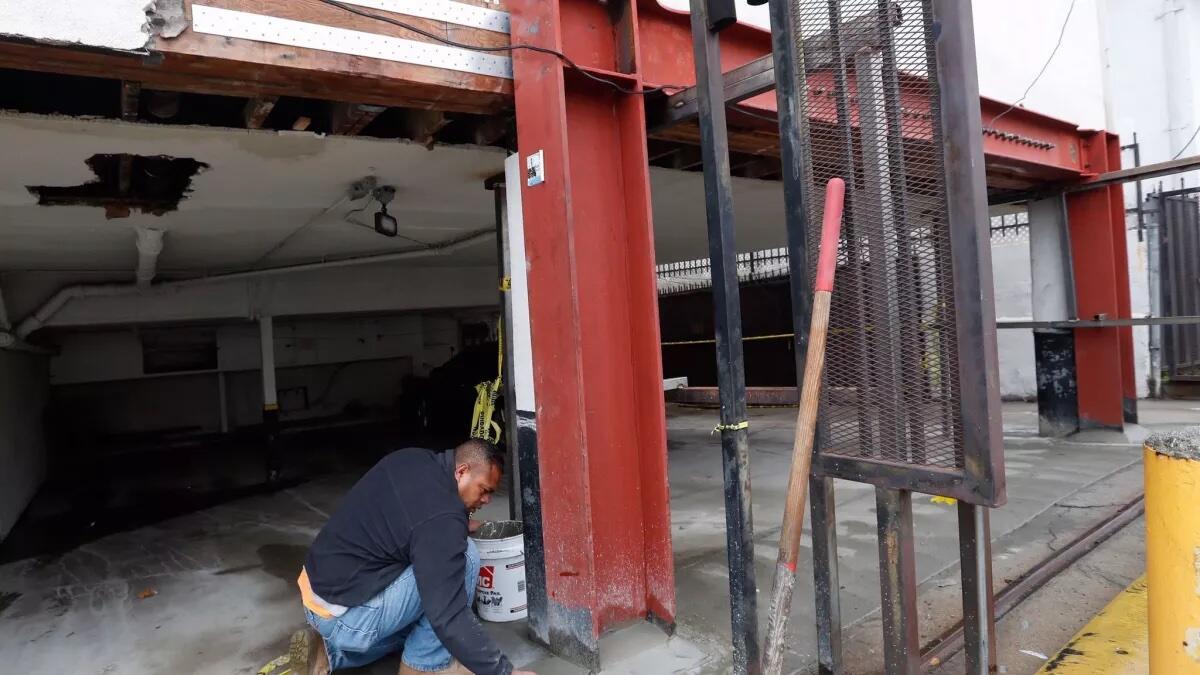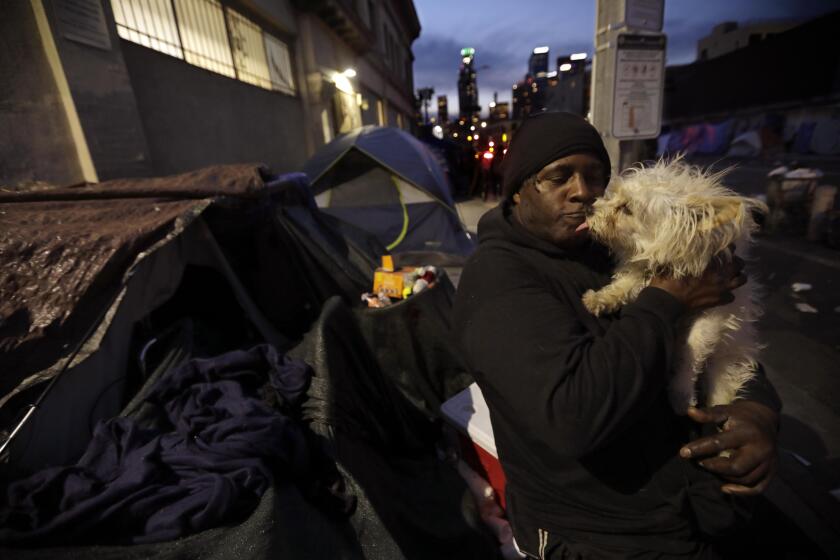When it comes to earthquakes, Republicans and Democrats agree on L.A. retrofitting, poll finds

Los Angeles residents strongly back the city’s landmark earthquake retrofit law, a new poll has found, despite decades of conventional wisdom that such a rule would be politically unpopular because of its cost.
More than 8 in 10 L.A. residents support the retrofit law, which passed in 2015 and targets certain vulnerable concrete buildings and apartment buildings with weak first stories, according to a Suffolk University/Los Angeles Times poll conducted March 9–12. Just 9% opposed the law, and 8% were undecided.
“Oh my God. That’s great! Wow ... I’m gratified,” seismologist Lucy Jones said of the survey results.
Jones, a former U.S. Geological Survey scientist, spent a year as science adviser to Mayor Eric Garcetti in 2014 to comprehensively study seismic safety in L.A. Garcetti subsequently proposed the retrofit law, which passed with the unanimous support of the City Council in October 2015, the most sweeping retrofit law of its kind nationwide.
In previous years, even some prominent supporters of mandatory retrofits had said it would be “political suicide” for council members to back such a costly requirement.
The poll showed bipartisan support for the retrofit law — a rarity at a time when many issues divide sharply along party lines. Among Democrats, 88% supported it, as did 77% of Republicans and 78% of independents.
Since the law passed, Los Angeles has made substantial progress in strengthening its earthquake-vulnerable apartment buildings with weak first stories, which are often known as “dingbats” or “soft story” buildings. Such buildings are ubiquitous across large swaths of Southern California and the San Francisco Bay Area, with housing units built atop carports propped up by flimsy poles, which are vulnerable to collapse in an earthquake.
A common retrofit technique for soft story buildings is to install steel frames on the ground story.
Of more than 12,400 buildings within city limits that have weak first stories, more than 8,600 have been retrofitted. That’s a completion rate of 69%.
The pricetag for those retrofits likely came to more than $1.3 billion, an analysis released in October said.
Progress has been much slower in retrofitting non-ductile concrete buildings — the other large category covered by the law. In such buildings, the configuration of steel reinforcing bars within the concrete frame is inadequate and allows the concrete to explode out of its columns when shaken, triggering a catastrophic collapse.
The city has more than 1,300 such buildings, and they were given a deadline of 25 years to complete the retrofit.
Structural engineers say, however, that they’re aware of dozens of concrete-building retrofit projects that are in some phase of being designed, with several underway.
Angelenos have taken notice of the pace of retrofits of apartments with weak first stories. According to the poll, 52% of L.A. residents said they believed some or a lot of progress has been made toward retrofitting older buildings to make them more earthquake resistant, compared to 24% who said they believed there has been very little or no progress.
What do Angelenos think about the start of Mayor Bass’ tenure? Is the emergency declaration on homelessness working?
Renewed attention to the threat of quake-vulnerable buildings in Los Angeles emerged after a Times investigation in 2013 which focused on non-ductile concrete buildings and on the city’s failure to act despite decades of awareness of the risk.
A U.S. Geological Survey simulation said a magnitude 7.8 earthquake in Southern California plausibly could cause 50 non-ductile concrete buildings to fully or partly collapse, with as many as 7,500 people in them.
Across California, only three cities have mandatory retrofit rules for non-ductile concrete buildings — L.A., Santa Monica and West Hollywood — leaving other major cities, like Long Beach, San Francisco and San Jose vulnerable.
Requirements to retrofit soft-story buildings are more common. In addition to Los Angeles, Santa Monica, West Hollywood, Culver City, Beverly Hills and Pasadena require retrofits. In Northern California, San Francisco, Berkeley, Oakland and Fremont do.
That still leaves many communities without a requirement, from beachside cities south of Santa Monica to the San Gabriel Valley, and across wide swaths of the San Francisco Bay Area, including Silicon Valley, which sits on the edge of the San Andreas fault, and Hayward, which lies directly on top of the Hayward fault.
San Jose and Long Beach have ordered inventories of soft-story apartments and are discussing ordinances to require retrofits.
Some earthquake safety advocates expressed hope the survey’s results would encourage other cities to adopt retrofit requirements.
“I’m really grateful that Los Angeles has moved on this. There are a lot of communities that are closer to the San Andreas [fault] that have not,” Jones said.
Garcetti said in a statement said he wasn’t surprised at the large majority in favor of the retrofit rule and that he hopes it spurs other cities to act.
“I’m glad that we did this difficult work and moved to protect lives, not in the wake of a deadly earthquake, but before disaster strikes,” Garcetti said. “It’s my deepest hope that all local jurisdictions in Southern California and across the country will follow this example — earthquakes don’t respect municipal boundaries.”
What L.A. residents have to say about police, public safety and racism among officers.
With the new focus on earthquake-vulnerable buildings, structural engineer David Cocke, the immediate past president of the Earthquake Engineering Research Institute, urged communities to go back and revisit their stock of vulnerable buildings and look at mandatory retrofits. Some communities, such as cities in the Inland Empire, haven’t yet ordered the demolition or retrofit of older brick buildings, also known as unreinforced masonry buildings, which Los Angeles addressed in 1981.
The new poll of 500 L.A. residents was conducted about a month after a series of powerful earthquakes — the strongest of which was magnitude 7.8 — sent shaking into Turkey and Syria, killing more than 52,000 people.
Many of the deaths occurred in the same type of non-ductile concrete structures that L.A.’s retrofit law targets.
As the death toll rose in Turkey and Syria, the Los Angeles County Board of Supervisors in February took the first step toward a mandatory earthquake retrofit order for non-ductile concrete buildings it owns, as well as any located in unincorporated areas of the county, including East L.A., Florence-Firestone, Hacienda Heights, South Whittier, Rowland Heights and Altadena. Roughly 1 in 10 L.A. County residents live in unincorporated communities.
Supervisors also ordered the creation of an inventory of residential buildings with weak first stories in the unincorporated area.
That order for an inventory sparked opposition from one lobbyist representing apartment owners. Max Sherman, of the Apartment Assn. of Greater Los Angeles, told the supervisors last month that creating an inventory of potentially vulnerable apartments would likely cause a dramatic increase in insurance premiums for building owners.
“While seismic retrofitting serves a vital need, it is important to recognize that these projects are extremely costly,” he said. “We ask the county to not start this process with housing providers still reeling from financial hardships” resulting from the pandemic, including months of missed rent from the eviction moratorium and a rent freeze.
But former L.A. City Council member Greig Smith, who was a quake safety advocate during his term, urged other local governments to act.
“Here’s the problem with government, having served 33 years in government: It is reactionary,” Smith said in an interview. He urged other council members: “Think forward, not backward.”
The Suffolk University/Los Angeles Times poll interviewed 500 adult residents of the city of Los Angeles, using live telephone calls to cellphones and landlines. Quota and demographic information — including region, race, and age — were determined from census and American Community Survey data. Surveys were administered in English and Spanish.
The margin of sampling error for the total sample is 4.4 percentage points in either direction. Error margins increase for smaller subgroups. All surveys may be subject to other sources of error, including but not limited to coverage error and measurement error.
More to Read
Sign up for Essential California
The most important California stories and recommendations in your inbox every morning.
You may occasionally receive promotional content from the Los Angeles Times.













